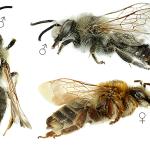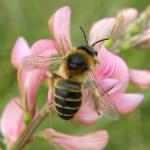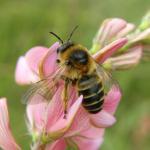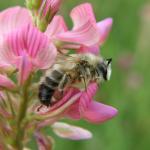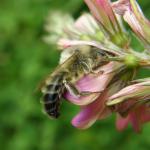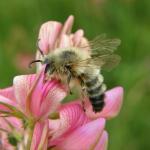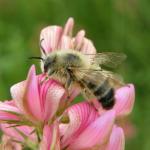Cilissa robusta RADOSZKOWSKI 1896
The first British specimen of this bee was collected near Tilshead, Salisbury Plain, Wiltshire, on 9 July 1949 by the late P W E Currie. However, about fifteen years were to elapse before its identity was established by D B Baker and the record published as Pseudocilissa dimidiata (Baker, 1964).
Known mainly from scattered sites on the three principal Army Ranges on Salisbury Plain (Imber, Larkhill, Bulford). A female of this species was also found on Walkers Hill, on the Pewsey Downs NNR. (to the north of the Plain) by G R Else and S P M Roberts on 19 July 1994. The bee also formerly occurred in a very restricted site at Easton Royal, in the Vale of Pewsey, where it was first found by K M Guichard in 1972. It apparently became extinct there about 1990, possibly as a result of overgrazing of the forage plant by rabbits, or of spray drift from adjacent farmland. The distribution and habits of this bee in Wiltshire have been described by Else & Roberts (1994). This is a central and southern European species whose range extends to western Russia. Baker (1964) provides a distribution map, although this does not include Spain (confirmed examples from that country are present in The Natural History Museum, London).
For many years the species was considered to be very rare, known only from a few sites in Wiltshire (Baker, 1964; Yarrow, 1968; Guichard, 1973). It is listed as Endangered (RDB1) in Shirt (1987) and by Falk (1991). However, recent surveys on Salisbury Plain have shown that the species is widely distributed there and flourishes in several locations (Else & Roberts, 1994); these observations suggest that its status should be revised.
Confined to chalk grassland supporting an abundance of sainfoin (Onobrychis viciifolia).
Univoltine; late June to early August.
Nests have not been encountered in England nor, apparently, on the continent. The nesting burrows are probably excavated in the soil.
Both males and females visit sainfoin (Onobrychis viciifolia) flowers. On Salisbury Plain males have also been found sheltering in the flowers of sainfoin, clustered bellflower (Campanula glomerata), field scabious (Knautia arvensis), viper's bugloss (Echium vulgare) and ox-eye daisy (Leucanthemum vulgare).
No information available.
Profile written: 1998
Proofed: January 2012


